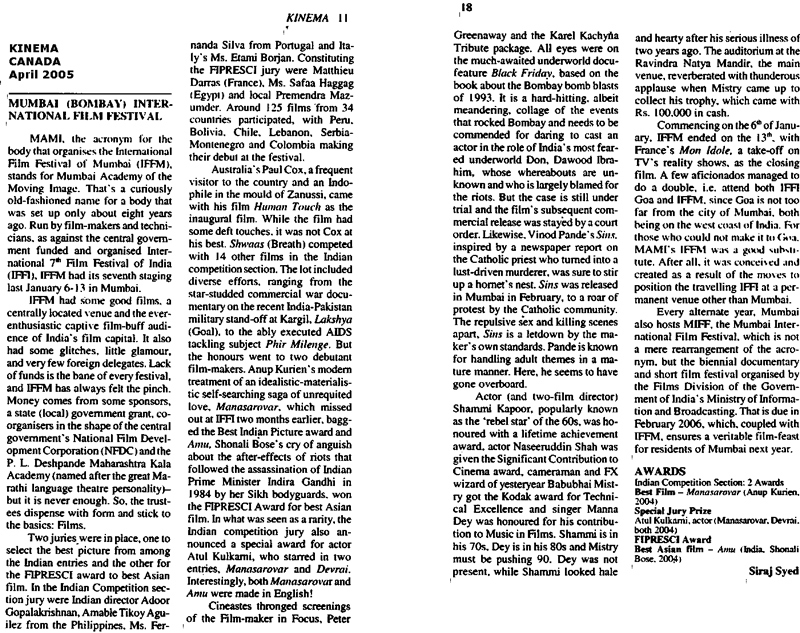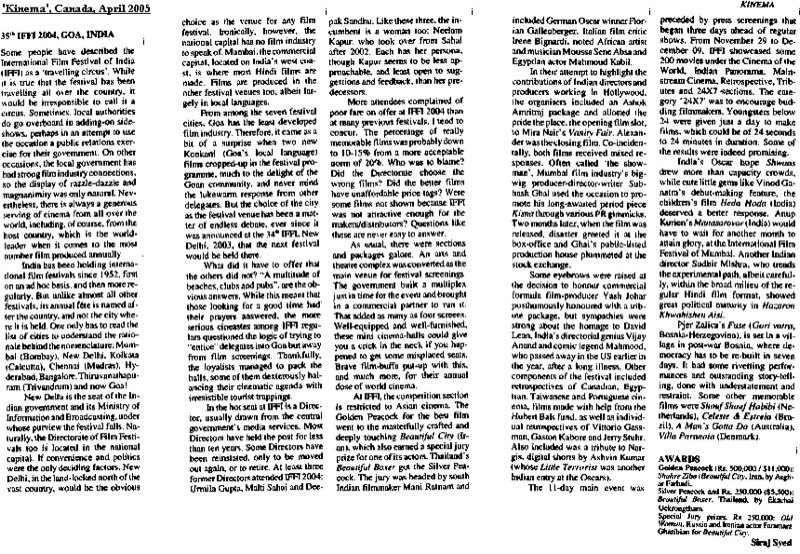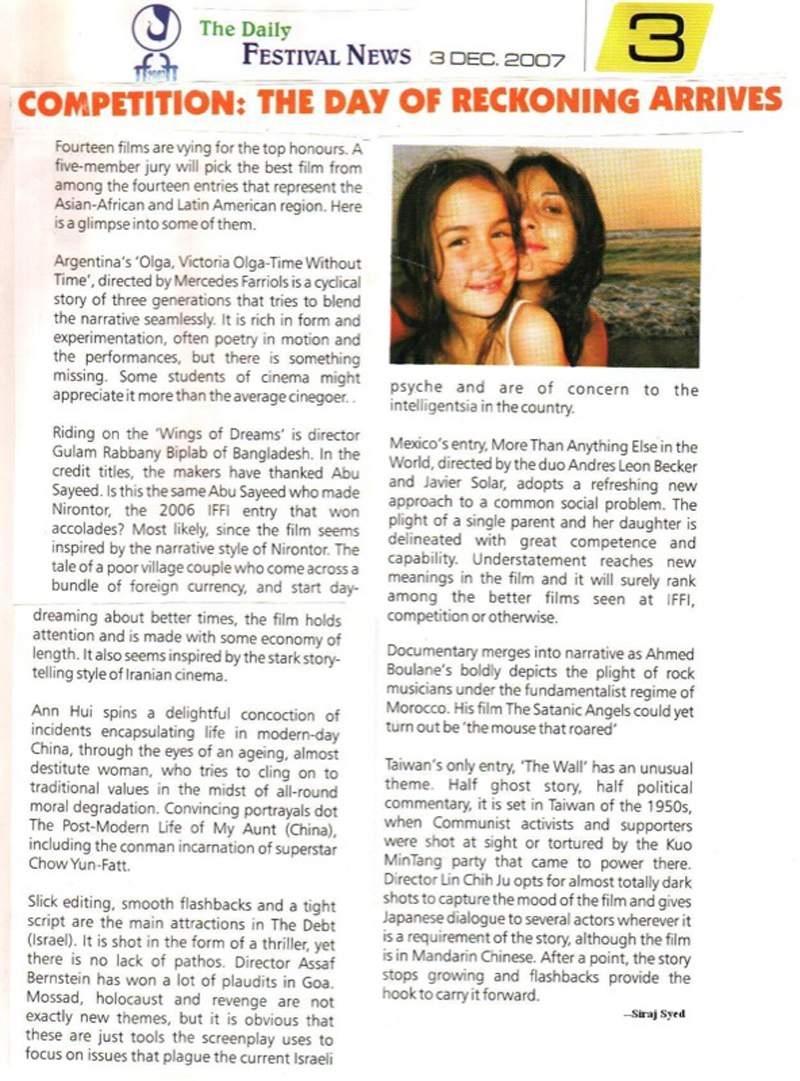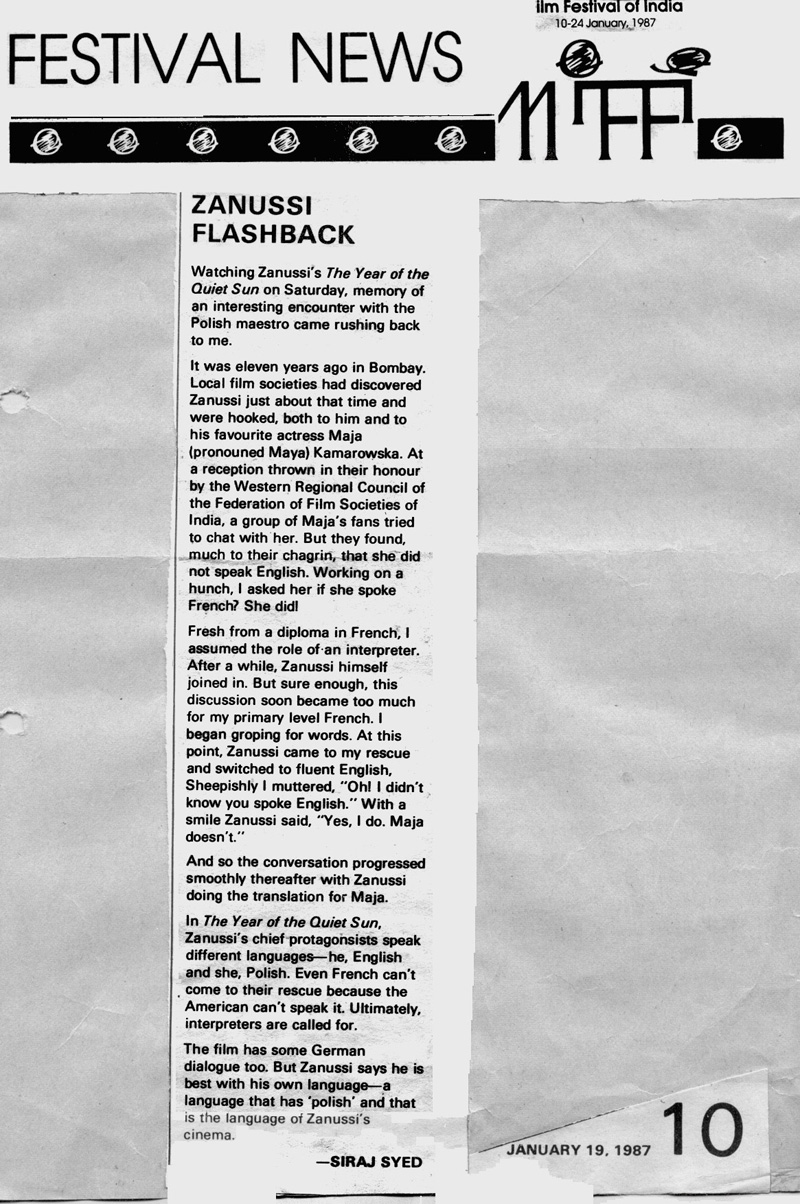|
|
||
|
Pro Tools
FILMFESTIVALS | 24/7 world wide coverageWelcome ! Enjoy the best of both worlds: Film & Festival News, exploring the best of the film festivals community. Launched in 1995, relentlessly connecting films to festivals, documenting and promoting festivals worldwide. Working on an upgrade soon. For collaboration, editorial contributions, or publicity, please send us an email here. User login |
Siraj SyedSiraj Syed is the India Correspondent for FilmFestivals.com and a member of FIPRESCI, the International Federation of Film Critics. He is a Film Festival Correspondent since 1976, Film-critic since 1969 and a Feature-writer since 1970. He is also an acting and dialogue coach. @SirajHSyed  Dawn of the Planet of the Apes, Review
Dawn of the Planet of the Apes Apes more human than homo sapiens, humans decimated by a simian flu, their two kingdoms separated by a boundary bridge in the USA, clichés that crossover from human story-telling to the world of our evolving Darwinian predecessors, role reversals on captivity and clinical trials, and the end of this eighth instalment laying the ground for the ninth movie in the 46-year-old science fiction franchise, based on a French novel, by Pierre Boulle—that’s the canvas of Dawn of the Planet of the Apes (directed by Matt Reeves), releasing in India on 11 July 2014, in 3D, in four languages: English, Hindi, Tamil and Telugu, the last three dubbed. It is 10 years after The Rise of the Planet of the Apes (2011, directed by Rupert Wyatt), in which Caesar (Andy Serkis), a super-intelligent chimp raised by humans, leads an ape uprising. A quick montage takes care of that back-story. Caesar has now established a thriving colony of genetically evolved apes in the Bay Area’s Muir Woods, and the human race has been devastated by a virus. A community of 2,000 apes, including a peace-loving circus orang-utan named Maurice (Karin Konoval) who looks like a Disney character, an angry lab survivor named Koba (Toby Kebbell), a gentle escapee from a primate shelter named Cornelia (Judy Greer) and a skilled fighter named Rocket (Terry Notary), live their lives, hunting meals, escaping predators, teaching youngsters and building a home under Caesar’s benevolent leadership. For the first eight years after the humanity-devastating virus, the apes were looking down from Muir Woods to San Francisco and could see lights and fires, but now it’s gone very quiet. But with the arrival of human survivors from a nearby colony across the bridge, including characters played by Jason Clarke, Keri Russell and Gary Oldman, conflict comes to the woods. In the first few minutes of the film, the apes communicate in grunts and sign language, interpreted by sub-titles. Later, with a turning point “Go”! Caesar sets the stage for a lot of English from some of the apes. Ape speech is highly varied, in various forms of grunts, screeches, crackles and the occasional words in plain English, though the intelligible words are twisted just enough to sound alien and sentences are halting, while still being understood if you pay good attention. The style of speech sprang, in part, from conversations Reeves, a new father, had with the actors about watching his son learn to speak. He also enlisted a child development specialist to help create the syntax. Of the apes, Caesar speaks most clearly, having been raised by a caring human who taught him to speak. London-born Andy Serkis, 50, Gollum in the Lord of the Rings series, reprises his role as Caesar from the 2011 film, in which he portrayed the chimp from birth to adulthood, using the tools of performance capture. “Caesar is one of the most complex, conflicted, interesting roles I’ve ever played,” said Serkis, who has also portrayed a serial killer, a punk rocker and King Kong. A great lot of Dawn is told from Caesar’s point of view. Reeves (who wanted to be an ape as a child, and has directed Cloverfield) has said, “Before Francis Ford Coppola shot The Godfather, he gathered his cast for a meal during which the actors all reflexively began deferring to Marlon Brando, establishing a crucial dynamic of the film.” In a forest in British Columbia, when he wanted to inaugurate another feared and respected screen leader, Andy Serkis as Caesar, he remembered that story, which Coppola had shared with him at a film class. “I had imagined that Caesar was the Don Corleone of the apes,” Reeves said. Maybe true, but appears an exaggerated approach or an unachieved attempt. Caesar is commanding, but not quite in the Don Corleone mould. A note on the incredible special effects in the film, particularly performance capture, created by Weta. As the actors were honing their performances, the visual-effects artists at Weta underwent research of their own. A zoo in Wellington, New Zealand, where Weta is based, allowed the artists to photograph chimps that had gone under anaesthesia for medical reasons and to take casts of their bodies. Because humans don’t have muzzles or heavy brows like apes, the work would help the artists craft the footage of the human actors into their furry, finished counterparts. Weta had a unique new challenge on this film--performance capture, which relies on hundreds of cameras to capture the movement of actors wearing markers on their bodies, is a technique that has primarily been used against green screens on soundstages. Weta brought their cameras outside and into the rainy, snowy woods of British Columbia for Dawn, making them wireless, hiding them in bushes and clamping them to tree branches. The advance allowed the actors to perform their scenes not on blank sound-stages, but in real outdoor environments. The digital makeup was being sculpted in three-dimensions by the wizards of Weta Digital and overlaid onto performances by Velcro/spandex-suited actors like Andy Serkis and Toby Kebbell. One crucial close-up of Serkis’ eyes was accomplished via Skype, when the actor was in London at his own performance capture-based studio, the Imaginarium, donning his headgear, as Reeves watched from a monitor in Los Angeles. But I must add that some of the apes’ eyes are just too human looking for comfort. In fact, the film ends on a close-up of Caesar’s eyes, and they really dig into you. Incidentally, an ape named Caesar first appeared in Escape from the Planet of the Apes, the third outing, as a child of time-travelling apes. Not quite the Caesar Wyatt and Reeves, and their writers have fleshed out. It's all happening on earth, and the films continue to have Planet of the Apes in their titles, perhaps to suggest that this is indeed the planet of the apes, humans being co-incidental. It is perplexing why the apes in this venture stand and stare for eternity at any point of conflict with humans, before taking any action. It is also too much of a co-incidence that the trees have branches without leaves at all the right heights to facilitate the leaping/swinging moves of the apes across long distances. A raid on the human armament store by errant apes is too stagey to be convincing. But there is enough good in the film to savour, including the magnificent sight of apes astride horses (just a little too frequent, though), a well-spread plot graph (yes, a bit slow-paced in the first half) and scale of the action. Rating: ***1/2 Trailer: https://www.youtube.com/playlist?list=PL4KCeouXMq3VKEoTqIOs9K1urD3EtkQSl 09.07.2014 | Siraj Syed's blog Cat. : Dawn of the Planet of the Apes Much to savour Performance capture review Weta Hollywood
|
LinksThe Bulletin Board > The Bulletin Board Blog Following News Interview with EFM (Berlin) Director
Interview with IFTA Chairman (AFM)
Interview with Cannes Marche du Film Director
Filmfestivals.com dailies live coverage from > Live from India
Useful links for the indies: > Big files transfer
+ SUBSCRIBE to the weekly Newsletter DealsUser imagesAbout Siraj Syed Syed Siraj Syed Siraj (Siraj Associates) Siraj Syed is a film-critic since 1970 and a Former President of the Freelance Film Journalists' Combine of India.He is the India Correspondent of FilmFestivals.com and a member of FIPRESCI, the international Federation of Film Critics, Munich, GermanySiraj Syed has contributed over 1,015 articles on cinema, international film festivals, conventions, exhibitions, etc., most recently, at IFFI (Goa), MIFF (Mumbai), MFF/MAMI (Mumbai) and CommunicAsia (Singapore). He often edits film festival daily bulletins.He is also an actor and a dubbing artiste. Further, he has been teaching media, acting and dubbing at over 30 institutes in India and Singapore, since 1984.View my profile Send me a message The Editor |



























